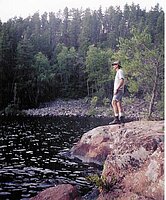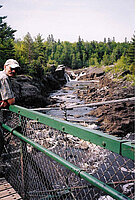The Impact of Wetlands and Wetland Easements on North Dakota Land Values

Kendall E. Goltz, after spending 26 years as a full-time, self-employed commercial beekeeper, Kendall Goltz decided to retire from beekeeping and return to the classroom. Kendall is a M.S. student in the Natural Resource Management program. He graduated from Concordia College, Moorhead, Minnesota in 1974 with a B.A. in Biology. Having a background that includes a lifelong interest in the outdoors, combined with many years of experience running a business closely tied to the natural world, has led Kendall to seek a research project where he could continue to work with the land. His research is focused on the impact of wetlands and wetland easements on the price of agricultural land in North Dakota. In addition, he is doing a pilot study to determine the impact of recreational land sales on the value of agricultural land in North Dakota.
Email: kbgoltz@msn.com
Phone: 218-861-6362
Fellow: Kendall Goltz, Department of Agribusiness & Applied Economics, NDSU
Advisor: Dr. Jay Leitch, Professor of Agricultural Economics, NDSU
Matching Support: Department of Agribusiness and Agricultural Economics, NDSU
Degree Progress: M.S. expected in December 2005.
From several years prior to the beginning of the environmental movement in 1970 up to the present there have been diligent efforts from a variety of groups, both public and private, to clean up our waterways and to restore and protect our wetlands. In recent years, conservation policy has emphasized the purchase of easements to increase the flow of environmental benefits from private lands. Federal and state agencies are typically required to pay a “fair market value” for easements but there is very little published information to assist in the determination of suitable payments. In residential and other more developed areas hedonic valuation method (HVM) models have successfully been employed to quantify wetland values. However, in North Dakota and other areas of production agriculture the implicit prices of wetlands and wetland easements have been difficult to quantify for a variety of reasons, including: low numbers of sales, imprecise measures of sale parcel productivity, the lack of capacity to determine hydrologic condition (wetness) and therefore the agricultural production potential of wetlands.
Both public and private conservation organizations have administered a number of easement programs in the Prairie Pothole Region of the upper Midwest since the early 1960s. This region has received special attention because it includes some of the highest concentrations of waterfowl breeding habitat in the continental United States and land values are relatively low. The largest of the easement programs is the US Fish and Wildlife Service Small Wetland Acquisition Program. It began in 1958 and is financed through the sale of Migratory Bird Hunting and Conservation Act Stamps. By 1998, forty years after the inception of the program, $46.7 million had been spent to purchase 1.2 million wetland easement acres in Montana, Nebraska, Minnesota, and North and South Dakota. Landowners who agree not to drain, fill, burn, or level existing wetlands are offered a one time lump sum payment. However, if wetlands happen to dry naturally certain farming activities such as grazing, harvesting hay, and growing crops are allowed since these activities are not considered damaging to the integrity of the wetlands under easement.
The EPA is currently funding research to evaluate the biological health of PPR wetlands as a function of adjacent agricultural land uses. It is anticipated that this research will aid in the development a methodology for ranking potential wetland sites for restoration, conservation, and/or acquisition.
Outdoor recreation, and especially hunting and fishing, is a multi-million dollar industry in the State of North Dakota. Many North Dakotans are avid hunters and fisherman who feel that the future quality of their outdoor experience is being threatened by people from outside the state of ND. Anecdotal evidence indicates that out of state hunters are buying land in North Dakota for recreational purposes at prices well in excess of local market values and driving up land values beyond the reach of beginning farmers. Thus, another purpose of this research is to determine the impact of recreational land sales on North Dakota agricultural land values.
Project Objectives:
- To determine the impact of wetlands and wetland easements on North Dakota land values.
- To determine the impact of recreational land sales on North Dakota land values.
- Refine the use of GIS technology to specify the attributes of sale parcels so that comparable market sales can be selected with greater speed and accuracy than has been possible in the past.
Progress to Date:
4,332 agricultural land sales from the years 2000 to 2004 have been collected from county courthouse public records in all 53 North Dakota counties. 775 of the 4,332 total land sales were found to contain wetland easements. The boundaries of all sales tracts have been digitized into a GIS database by identifying and selecting field boundaries in the common land unit (CLU) database of the NRCS based on the legal descriptions of the database. Land uses (acres of cropland vs. pastureland) have been calculated through spatial overlay of the year 2003 or 2004 NASS CDL coverages. The relative productivity of the sale parcels is represented by spring wheat yields for cropland, and pounds of forage per acre for pastureland. These soil productivity measures were calculated through spatial overlays of tracts and the SSURGO soils database. The type of wetlands found within the sale tracts has been quantified using spatial overlays of the NWI Basin. Conservation easement acres within sale tracts were determined by overlaying USFWS easement boundaries with the sale tract and NWI wetland coverages. The hydrologic (wetness) condition of all wetlands and easements has been determined using spatial overlays of water classifications of the NASS CDL , and visual inspections of overlaid NAIP color aerial photography.
In addition, 210 land purchasers that reside either in one of the larger North Dakota cities or outside the state were identified as potential recreational land buyers. Survey information about the nature of the sale was obtained from 152 of the 210.
Significance:
It is anticipated that a methodology for agricultural land appraisals upon which to base the value of easement to offer a landowner and the ranking of potential wetland sites for restoration, conservation, or acquisition will emerge from this research. It is important to understand the implicit prices of wetlands and wetland easements to landowners so that a better prediction can be made of landowner willingness to restore, conserve, or degrade specific wetlands; and fair market levels of compensation to landowners can be calculated. GIS techniques for specifying sale parcel attributes is expected to improve.
State policy makers will benefit from knowing the impact of out of state buyers of recreational land on land values in North Dakota.


Dr. Jay Leitch
Agricultural Business and Applied Economics
North Dakota State University


